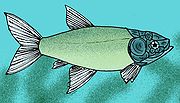
Leptolepis
Encyclopedia
Leptolepis is an extinct genus of teleost fish that lived in the Mesozoic
era. It was one of the first teleosts.
 Leptolepis was about 30 centimetres (11.8 in) long, and resembled a modern herring
Leptolepis was about 30 centimetres (11.8 in) long, and resembled a modern herring
, although it was not a close relative of those fish. It was the first true bony fish to really live up to the name, possessing a skeleton completely made of bone
; some previous genera such as Pholidophorus
had skeletons composed of bone and cartilage
. Another modern development in Leptolepis were its scales
, which lacked the covering still present in previous genera. These two developments made swimming easier, as the bony spine
was now more resistant to the pressure caused by the S movements made while swimming.
Mass graves of Leptolepis have indicated that it probably lived in schools
which would provide some protection from predators while the creatures fed on surface plankton
. Pelagosaurus
was a known predator of Leptolepis after a Pelagosaurus fossil was found with Leptolepis remains in its stomach.
A 13 centimetres (5.1 in) fish that was deeper bodied than its co-occurring contemporaries Morrolepis and Hulettia. The Morrison cf. Leptolepis probably had a live mass of about 37 grams (1.3 oz). It is the only teleost fish known from the formation and was morphologically more highly derived than other Morrison fish. A specific example of apomorphy in cf. Leptolepis is its "more modern tail structure" compared to Morrolepis. It is believed to have fed on contemporary fish and small invertebrates.
Mesozoic
The Mesozoic era is an interval of geological time from about 250 million years ago to about 65 million years ago. It is often referred to as the age of reptiles because reptiles, namely dinosaurs, were the dominant terrestrial and marine vertebrates of the time...
era. It was one of the first teleosts.
Appearance

Herring
Herring is an oily fish of the genus Clupea, found in the shallow, temperate waters of the North Pacific and the North Atlantic oceans, including the Baltic Sea. Three species of Clupea are recognized. The main taxa, the Atlantic herring and the Pacific herring may each be divided into subspecies...
, although it was not a close relative of those fish. It was the first true bony fish to really live up to the name, possessing a skeleton completely made of bone
Bone
Bones are rigid organs that constitute part of the endoskeleton of vertebrates. They support, and protect the various organs of the body, produce red and white blood cells and store minerals. Bone tissue is a type of dense connective tissue...
; some previous genera such as Pholidophorus
Pholidophorus
Pholidophorus is an extinct genus of teleost fish from the Triassic and Jurassic periods of Africa, Europe, and South America.Pholidophorus was a herring-like fish about long, although it was not closely related to modern herring. Like them, however, it had a single dorsal fin, a symmetrical tail,...
had skeletons composed of bone and cartilage
Cartilage
Cartilage is a flexible connective tissue found in many areas in the bodies of humans and other animals, including the joints between bones, the rib cage, the ear, the nose, the elbow, the knee, the ankle, the bronchial tubes and the intervertebral discs...
. Another modern development in Leptolepis were its scales
Scale (zoology)
In most biological nomenclature, a scale is a small rigid plate that grows out of an animal's skin to provide protection. In lepidopteran species, scales are plates on the surface of the insect wing, and provide coloration...
, which lacked the covering still present in previous genera. These two developments made swimming easier, as the bony spine
Vertebral column
In human anatomy, the vertebral column is a column usually consisting of 24 articulating vertebrae, and 9 fused vertebrae in the sacrum and the coccyx. It is situated in the dorsal aspect of the torso, separated by intervertebral discs...
was now more resistant to the pressure caused by the S movements made while swimming.
Mass graves of Leptolepis have indicated that it probably lived in schools
Shoaling and schooling
In biology, any group of fish that stay together for social reasons are said to be shoaling , and if, in addition, the group is swimming in the same direction in a coordinated manner, they are said to be schooling . In common usage, the terms are sometimes used rather loosely...
which would provide some protection from predators while the creatures fed on surface plankton
Plankton
Plankton are any drifting organisms that inhabit the pelagic zone of oceans, seas, or bodies of fresh water. That is, plankton are defined by their ecological niche rather than phylogenetic or taxonomic classification...
. Pelagosaurus
Pelagosaurus
Pelagosaurus is an extinct genus of thalattosuchian crocodyliform that lived during the Toarcian stage of the Lower Jurassic, around 183 Ma to 175 Ma , in shallow epicontinental seas that covered much of what is now Western Europe...
was a known predator of Leptolepis after a Pelagosaurus fossil was found with Leptolepis remains in its stomach.
The Morrison cf. Leptolepis
Known only from a single nearly complete skeleton found at Rabbit Valley, Colorado.A 13 centimetres (5.1 in) fish that was deeper bodied than its co-occurring contemporaries Morrolepis and Hulettia. The Morrison cf. Leptolepis probably had a live mass of about 37 grams (1.3 oz). It is the only teleost fish known from the formation and was morphologically more highly derived than other Morrison fish. A specific example of apomorphy in cf. Leptolepis is its "more modern tail structure" compared to Morrolepis. It is believed to have fed on contemporary fish and small invertebrates.

